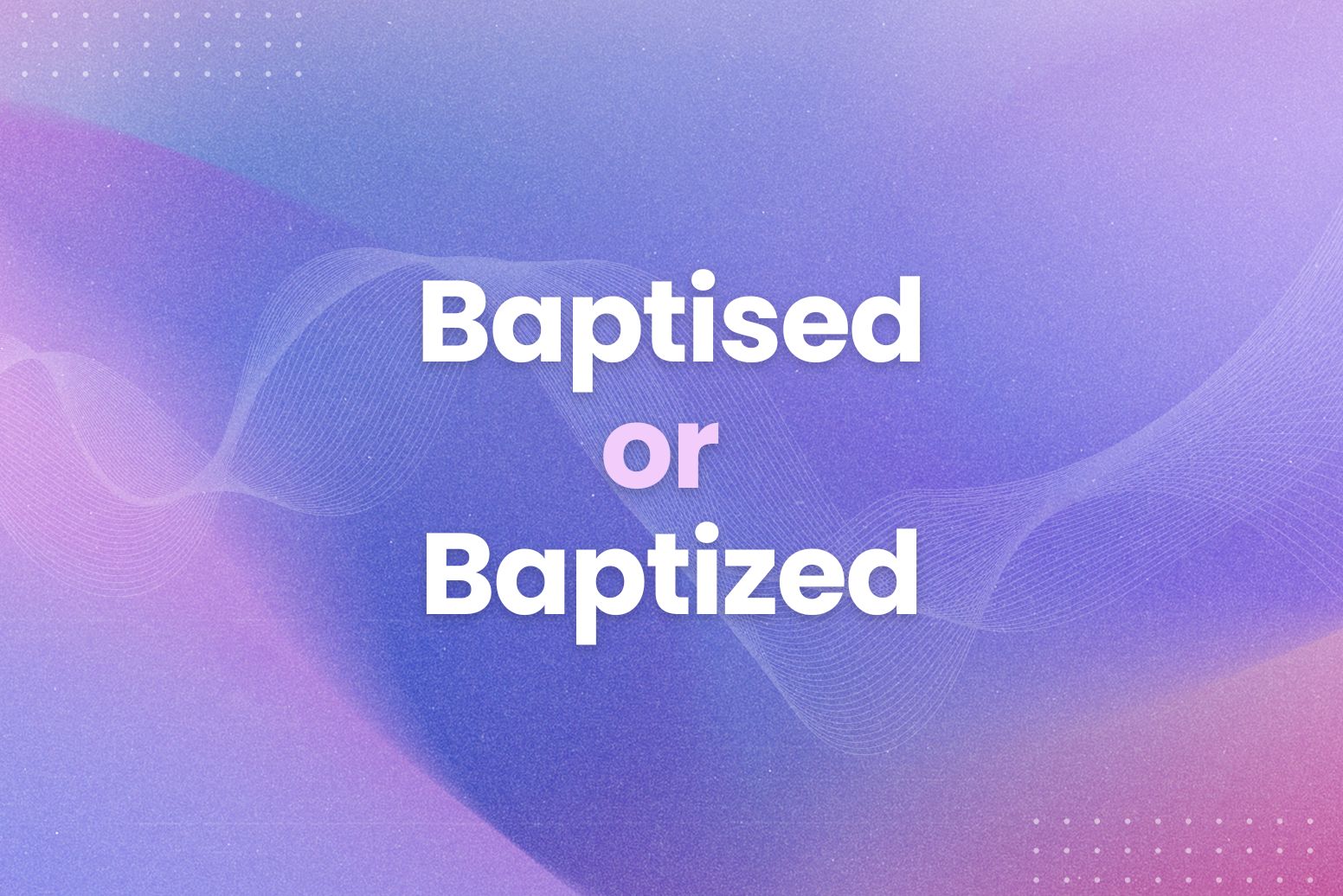Ever paused mid-sentence and wondered, “Is it baptised or baptized?” Don’t worry—you’re not alone! These two words may look different, but they share the exact same meaning. The choice between them depends entirely on which side of the Atlantic you’re on. In this guide, we’ll explore everything you need to know about baptised vs. baptized.
First time exploring British and American English? Let Arvin AI‘s free Grammar Checker be your writing assistant!
Definition of Baptised and Baptized
Baptised and baptized mean the exact same thing— both refer to the Christian sacrament of baptism, symbolizing purification or initiation into the faith. Their spelling changes depending on where you are in the world.
Baptised is the British English spelling, used in places like the UK, Australia, and South Africa. Whereas baptized is the American English version, used in the US and Canada.
British vs. American English Spelling
The spelling differences between baptised and baptized are part of the larger quirks between British and American English.
British English (Baptised)
The British spelling sticks with the traditional -ise ending, which comes from French and Greek roots, and is consistent across words like “organise,” “realise,” and “baptised.”
- “She was baptised in the local church last Sunday.”
American English (Baptized)
In the 19th century, Americans opted for simplified spellings, replacing -ise with -ize in many verbs. Henceforth, words like “baptized,” “organized,” and “realized” are now standard in the US.
- “The baby was baptized in a beautiful garden ceremony.”
So the rule of thumb is: If you’re writing for a British audience, go with baptised. However, if your readers are American, stick to baptized. Simple!
Historical Context: Baptised or Baptized?
Ever wondered why there were two versions of the same word?
Early Origins
The word comes from the Greek baptizein, meaning “to immerse or dip.” The spelling baptised reflected its Greek and Latin roots when translators created English Bibles like the King James Version (1611).
American Simplification
Noah Webster, the guy behind Webster’s Dictionary, decided in the 19th century that American English needed to be simpler and more distinct. This led to -ize replacing -ise in many verbs, including “baptized.”
Religious Texts
Even though older British church documents use “baptised,” many modern Bibles (like the NIV) use “baptized” to cater to a global audience. Still, British churches and traditions often stick to baptised.

Struggling with British vs. American spelling? Let Arvin AI guide you to perfect grammar every time!
Grammar Rules
Both baptised and baptized are past tense and past participles of the verb baptise/baptize.
However, they differ in their spelling, depending on the geography of where you use the word. Use baptised when writing in British, Australian, or Commonwealth English, and baptized for American or Canadian English.
Examples of Baptized
- They baptized Dr. Martin Luther King Jr. at the historic Ebenezer Baptist Church in Atlanta, where he later preached.
- Reverend C.L. Franklin baptized the late Aretha Franklin in Detroit, showcasing her deep roots in gospel music.
- During his spiritual transformation, Kanye West baptized his children in the Jordan River, a location of great religious significance.
Examples of Baptised
- In 2013, they baptised Prince George of Wales, the eldest son of Prince William and Kate Middleton, at St. James’s Palace in London.
- Historically, villagers baptised Joan of Arc in the small French village of Domrémy-la-Pucelle, following a tradition essential for all Christians of her time.
- In 800, they baptised Charlemagne as a Christian before his coronation as Holy Roman Emperor.
- They famously baptised Queen Victoria in Kensington Palace, with her godparents including the King of Prussia.
Curious about baptism’s meaning across cultures? Explore the deeper significance with Arvin AI.
Key Differences Between Baptised and Baptized
| Aspect | Baptised | Baptized |
| Spelling | British English | American English |
| Regions | Common in the UK, Australia, South Africa | Used in the US, Canada, and other American regions |
| Historical Use | Derived from traditional British spelling | Simplified by Noah Webster in 19th-century America |
| Example Sentence | “The baby was baptised in St. Paul’s Cathedral.” | “The child was baptized at the local church.” |
Why Are Baptised and Baptized Confusing?
It’s easy to mix up baptised and baptized, and it all comes down to a few key factors.
First, both words are pronounced the same way (/ˈbæp.taɪzd/), making them homophones—there’s no audible difference when spoken. On top of that, they mean exactly the same thing, so the only distinction lies in whether you’re using British or American English.
Plus, regional preferences add to the confusion; in today’s global conversations, you might encounter both spellings in the same context, like a British reader using “baptised” while an American opts for “baptized.”
Undeniably, religious texts also play a role in the mix-up, as many modern translations favor “baptized” to appeal to a wider, international audience—even in regions where British spelling is typically used.
Finally, technology can muddle things further, with spell checkers often defaulting to American English and automatically correcting “baptised” to “baptized” unless adjusted.
Synonyms for Baptised/Baptized
Christened
Refers to the ceremonial naming during a baptism, often in Christian traditions.
- They christened Prince George of Wales in a grand ceremony at St. James’s Palace.
Initiated
It highlights formal admission to a group, faith, or tradition.
- Pope John Paul II emphasized initiating individuals into the faith through baptism.
Purified
Focuses on the symbolic cleansing aspect of baptism.
- The Jordan River purified many pilgrims, including Jesus himself, who was baptized there.
Anointed
Used to describe a spiritual blessing or consecration, often accompanying baptism.
- They often anoint kings and queens of England as part of their religious coronation rites.
Immersed
Directly refers to full immersion in water during baptism, a practice common in some Christian denominations.
- The pastor immersed the new believer in the river, marking their entry into the faith.
Dipped
A more literal synonym for water-based baptisms, often used informally.
- Early Christians dipped themselves in rivers as a sign of their commitment to the faith.
Blessed
Signifies being spiritually sanctified, often connected to baptismal rituals.
- They blessed Saint Teresa in a simple ceremony that marked the beginning of her religious journey.
Welcomed
It conveys acceptance into a community or religious group.
- Many churches see baptism as a way to welcome new members into the faith.
Consecrated
It indicates formal dedication to a religious purpose, often linked to baptism.
- Pope Francis emphasized consecrating individuals through baptism to live a life of faith.
Inducted
Describes formal admission to a group or role, used metaphorically for baptism.
- They inducted the young monks into the order after a sacred baptismal rite.
Reborn
Symbolizes spiritual renewal or rebirth, a key aspect of baptism.
- Many evangelicals describe being reborn in Christ through the act of baptism.
Cleansed
Emphasizes the act of removing sin or impurity, often a core theme in baptism.
- John the Baptist cleansed thousands in the Jordan River as part of their spiritual preparation.
Named
Tied to the tradition of giving a Christian name during baptism.
- At the ceremony, the priest named the child Thomas, after the apostle.
Sanctified
It refers to being made holy or set apart for God, often associated with baptism.
- In early Christianity, converts were sanctified through a formal baptism ceremony.
Religious and Cultural Significance
Biblical Roots:
John the Baptist baptized Jesus Christ in the Jordan River, a moment central to Christian teachings. The Gospels describe this event as a model for believers, with John proclaiming, “I baptize you with water, but he will baptize you with the Holy Spirit.”
Sacrament of Baptism:
For Catholics, baptism is a sacrament necessary for salvation. Pope Francis often highlights baptism’s role as the “door to faith,” urging parents to baptize their children early to welcome them into the church.
The Orthodox Church emphasizes full immersion in water, symbolizing death to sin and resurrection in Christ, often conducted in elaborately decorated baptismal fonts.
Infant Baptism:
Common in Catholic, Anglican, and Orthodox traditions. For example, Prince Louis of Wales was baptized in 2018 at The Chapel Royal, following the centuries-old royal tradition.
Adult Baptism:
Practiced by Baptists and Pentecostals, where individuals consciously choose baptism as a public declaration of faith. Famous evangelist Billy Graham often preached about the transformative power of adult baptism.
Royal Traditions:
Royal baptisms have long been a cornerstone of monarchies. For example, they baptized Queen Elizabeth II in the private chapel at Buckingham Palace in 1926, using water from the River Jordan, a tradition later continued with Prince George and Princess Charlotte.
These ceremonies often blend grandeur with spirituality, underscoring the monarch’s dual role as both sovereign and spiritual leader.
Missionary Movements:
St. Augustine of Canterbury, sent by Pope Gregory I, baptized King Æthelberht of Kent in 597 AD. This event marked a turning point in converting Anglo-Saxon England to Christianity.
In the Americas, mass baptisms during the Spanish missionary era, such as those led by Father Junípero Serra in California, symbolized both religious conversion and cultural integration.
Festivals and Public Celebrations:
In Ethiopia, the Timket festival celebrates the baptism of Jesus in the Jordan River. The event includes processions, prayers, and mass baptisms, with thousands immersing themselves in rivers or pools.
In Latin America, baptism ceremonies often combine religious rites with cultural festivities, featuring godparents, traditional foods, and music.
Pope Francis often reflects on his baptism at the Basilica of Mary Help of Christians in Buenos Aires, emphasizing its role in shaping his faith journey.
Final Words on Baptised or Baptized
When it comes to choosing between baptised and baptized, the difference boils down to regional spelling preferences. Baptised aligns with British English, while baptized follows American English conventions. Both words, however, carry the same profound meaning rooted in faith, purification, and rebirth, making them universally significant regardless of how they’re spelled.

Confidently use baptised or baptized in your writing. Check your spelling with the Arvin AI Grammar Checker today!
FAQ
Being baptised means undergoing a religious ceremony that symbolizes purification, rebirth, and admission into the Christian faith.
Christening refers to naming a child during baptism, so it’s a type of baptism, especially in infant ceremonies.
“Baptize” is the American English spelling, while “baptise” is British English.
“Baptizing” is the act of performing the ritual, while “baptism” refers to the ceremony or sacrament itself.
Catholicism uses both spellings, following regional language preferences (British: baptised, American: baptized).
It refers to receiving the Holy Spirit, symbolizing spiritual empowerment and connection with God, often emphasized in Pentecostal traditions.
It rhymes with “haze” or “maze” and is pronounced /ˈbæp.taɪz/.






